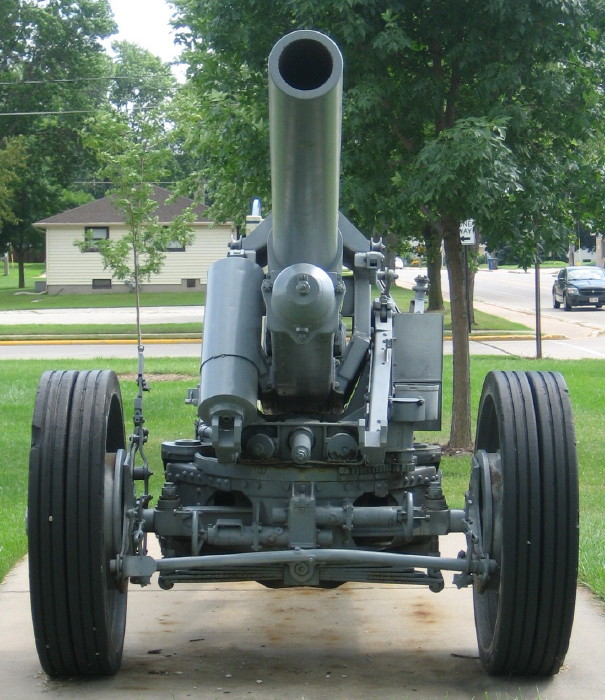
Clocking in at almost 26 feet in length, the German heavy field howitzer model 18 is an impressive sight to behold. After years of use in WWII on the eastern front, this howitzer was captured in the Battle of El Guettar in Tunisia after an allied victory. In 1946 it was acquired by Jacob Coppus American Legion Post #258, and transported to its final resting spot in Little Chute, Wisconsin.
Origin
The final heavy field howitzer model 18 design is actually a combination of two designs. Originally both Rheinmetall and Krupp – two of the largest defense contractors in Germany at the time – were competing to get their design accepted by the government. After both sides had several rejected designs, the army decided to combine the best parts of both designs. The final design is a combination of a Rheinmetall built gun on top of a Krupp carriage. This design competition was started in 1926, and was officially introduced into service in 1935.
Normally, the model number would correspond to the year it was designed in, as exemplified by the Model 13 being designed in 1913. However, the model 18 was designed in 1926, and this numbering scheme was intentional. The German army wanted to keep the howitzer’s development a secret because it was a direct violation to the Treaty of Versailles. They chose the model number 18 because the Treaty of Versailles was not signed until 1919, so howitzer plans from 1918 would not cause any suspicion if they got out. Once German rearmament started in 1933, they released the design plans and started production.
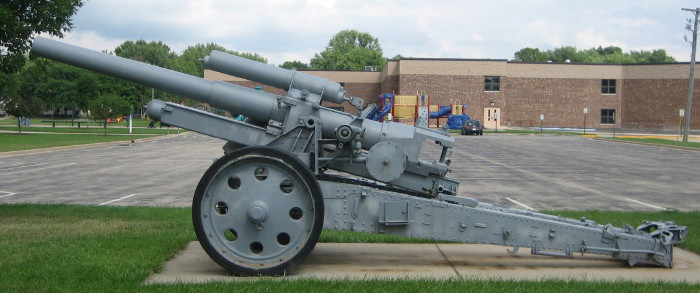
Design Features & Model Variation
The original model was designed to be drawn by horse, but as WWII progressed, it was quickly modified to be towed by machine. The pictured howitzer can be identified as the later, machine drawn model because it has no wheels in the back, only the two located near the middle. While the back wheels were removed so it could be towed, there was still no suspension so it could not be towed very fast.
After the Axis invasion of the Soviet Union, the German army realized that they were being outranged by Soviet artillery. This led them to make modifications to the sFH 18 to increase the range. While the modifications did work, the howitzer was never meant to withstand that power and there were bad side effects that weakened the barrel and recoil mechanism over time. These modified versions went by the name “15 cm sFH 18(m)”.
Even later towards the end of the war, they started mounting the guns onto motorized chassis, forming a self-propelled artillery system. This system would go on to be used in Hitler’s Atlantic Wall, a giant line of coastal defense systems formed between 1942 and 1944. The gun’s design was so good many countries picked up the design after the war and continued using it for years with their own modifications. For example, The Republic of China designed one with a longer barrel and range, and the Czech Republic made a design with a shorter barrel, but significantly better recoil compensation.
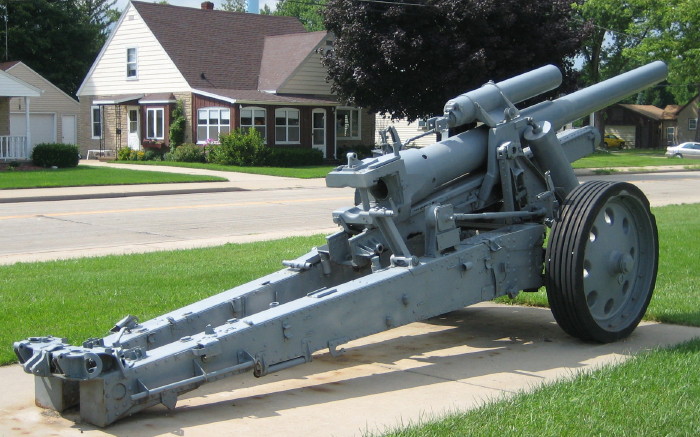
Military Presence
Over the seven primary years of production (1939 to 1945) almost 7,000 Heavy field Howitzer model 18s were produced, with the majority being produced in 1944 near the end of the war. The pictured howitzer was specifically used on the eastern front, coastal defense, and the North African campaign during World War 2. The model 18 howitzer first saw combat in the second Sino-Japanese War. Although the Chinese didn’t have many of them, the howitzers were significantly better than any artillery the Japanese had at the time. When the Axis attacked the soviet union 4 years later, they found the opposite to be true. The Soviet Union had already developed artillery with over twice the range of the model 18.
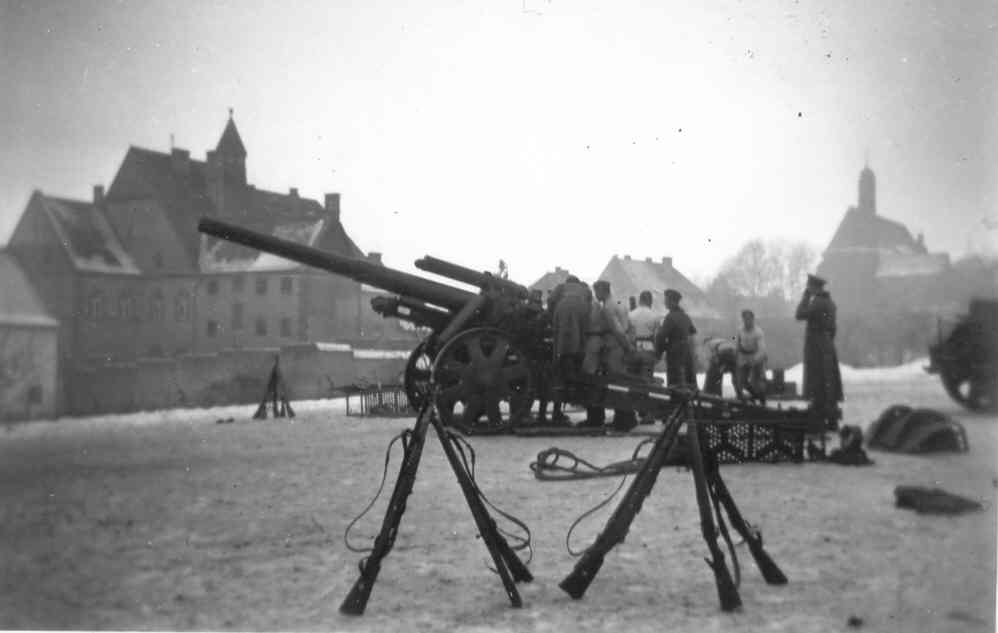
New Tech
Although the howitzer model 18 was already obsolete within a decade of its release, it resulted in several new technologies that are still used to this day. The model 18 was the first artillery to use a rocket-assisted projectile, which allowed it to fire 4.5 kilometers farther than the previous howitzer model 13. A rocket-assisted projectile is a round that incorporates a rocket motor for propulsion, giving it significantly more speed and range than a normal shell. Combined with the muzzle velocity increase of 40%, the model 18 outclassed the model 13 in nearly every way.
The model 18 howitzer was also built using a modular design that allowed for customization and easier repair. This is partially because of the competition between Rheinmetall and Krupp that resulted in designs being combined into one. This led to many design modifications over the next few years, including the 15cm howitzer 36, a model that weighed half as much as the 18, but was discontinued due to lack of materials.
Although the modular design helped with customization, each howitzer still took 9 months and 5,500 man-hours to build. Each howitzer 18 cost 40,400 Reichsmark to make, which translates to almost $60k today, accounting for inflation. Although these numbers seem high, they were still able to produce 6,756 in just over 10 years, 2,295 of which were produced in 1944 alone! This is approximately twice the number of model 13 howitzers produced during World War 1. This also demonstrates the importance of artillery in World War 2.
One of the more important improvements the model 18 had over the model 13 was the swivel range. Swivel range is the range in degrees that the barrel can rotate left or right without having to relocate the body of the howitzer. The model 13 only had 5 degrees of swivel range, which meant that if you wanted to fire at anything more than 2.5 degrees in either direction you had to lift the back end and rotate the while thing. Rotating the 2,250 kg model 13 was not an easy task, and if they had to rotate the 6,304 kg model 18 every time, it would be nearly worthless. Krupp and Rheinmetall kept this in mind while designing the model 18 and gave it a huge swivel range of 60 degrees, one of the largest in the entire line of 15cm howitzers.
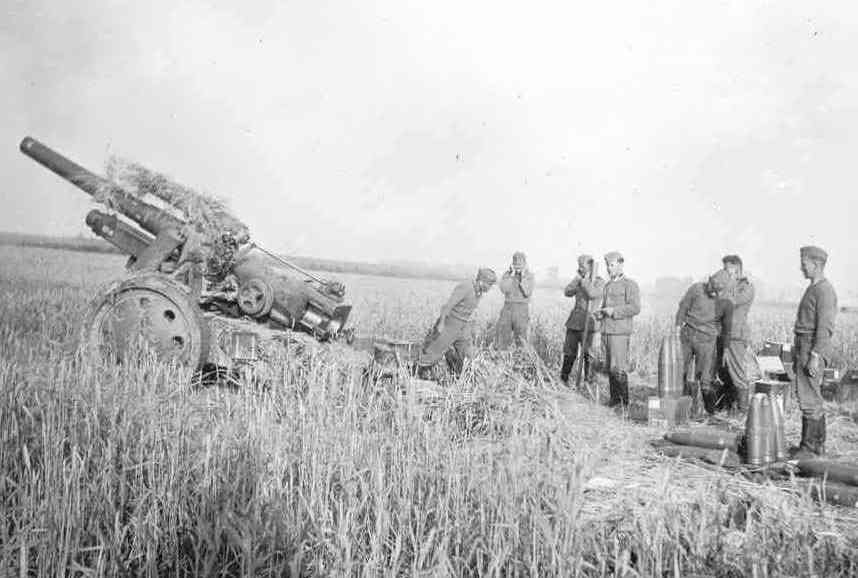
Design Problems
While the model 18 was ahead of its time, it did have a few problems that prevented it from being great. First, the weight. The model 18 weighed 6,304 kg, or almost 14 thousand pounds. This put it at about three times as heavy as the previous model 13. This was a notable problem because it meant that the model 18 was significantly harder to maneuver in combat. Even once the axle was implemented, it could not be towed at high speeds due to lack of suspension. Several attempts were made to solve this issue, but they were mostly inconclusive. In 1935 Rheinmetall created the 15cm howitzer 36, a light weight version specifically designed to be horse drawn for non-motorized divisions. They succeeded in dropping the weight down to 3,450 kg, or about 7600 pounds, but the design was primarily composed of light metal that was largely unavailable at the time. As a result, it was only produced from 1938 to 1942 in very small batches.
Second, the model 18 had an outdated firing elevation. Almost all features of the model 13 had been improved upon for the model 18, except for the firing elevation. Both the model 13 and model 18 have a firing elevation maximum of 45 degrees. The model 13 technically had a larger firing elevation range, going from -4° to 45° while the model 18 only went from 0° to 45°. Sometimes called “tube elevation”, the firing elevation of an artillery weapon is the angle the projectile is fired at. While a firing elevation of 45° results in the farthest distance, greater elevations were sometimes used to increase flight time or angle of descent. Rheinmetall and Krupp attempted to increase the firing elevation for a later howitzer model, the 15cm model 40. They were very successful in increasing the elevation, so much so that they doubled the angle to 70 degrees maximum. However, the model 40 was even heavier than the model 18, and was found to be too difficult to use in the field. As a compromise, they used the barrel design from the model 40 and attached it to model 18’s, creating the 15cm model 18/40.
Finally, the original model was designed around being towed by a horse, and not a motorized vehicle. Because of this, it was designed using hard rubber tires, and an axle without a spring. While these worked at lower speeds, they were not suitable for motorized towing. Rheinmetall and Krupp tried to solve this by replacing the main carriage with a two-wheel bogie, but this was not a perfect solution. The absence of any suspension prevented it from going at faster speeds, which made it harder to move them over long distances. Several later designs were actually able to fix this by replacing the entire metal carriage, like in the 15 cm sFH 40 for example. Replacing the carriage did make the gun heavier, but that was a small price to pay when compared to the benefits of motorized towing.

Present Day
The 15cm model 18 howitzer is a German artillery, so how did it end up in Little Chute, Wisconsin? According to the commemorative plaque in front of the howitzer, it most likely came from the Battle of El Guettar in Tunisia in 1943. It also notes that the howitzer was used on the “eastern (Russian) front, coastal defense and the North African campaign during the second world war.” The postscript on the plaque notes that the howitzer was “Acquired 1946 by Jacob Coppus American Legion Post #258”. Because it was acquired after World War II ended in 1945, it was most likely acquired while World War II trophies were being distributed after the war.
Battle of El Guettar
It is very noteworthy that the captured howitzer in Little Chute is likely from the battle of El Guettar because that was one of the first battles where U.S. forces were able to overcome German artillery and tank units. The battle was part of the Tunisian Campaign, a series of battles in the North African Campaign during World War II.
The battle started when the German 10th Panzer Division charged to attack U.S. artillery at the top of a hill. Their plan was to ride motorized units as far up the hill as possible, and then dismount and continue on foot. Their plan fell apart when they ran into a minefield. They failed to reorganize, and once U.S. artillery engaged, over 30 German tanks were taken out within the hour. The German division retreated. After an hour another charge was made only to have a similar result, and the rest of the 10th Panzer Division went back to the German headquarters.
This battle is important because it was the first time U.S. troops were able to win against the more experienced German tank and artillery units. It was also able to prove that although the American troops were less experienced, they were still able to hold their ground against the German attack.
Primary Sources
- Barron, Leo. Pattons First Victory: How General George Patton Turned the Tide in North Africa and Defeated the Afrika Korps at El Guettar. Stackpole Books, 2018.
- Engelmann, Joachim, and David Johnston. German Heavy Field Artillery 1934-1945. Schiffer, 1995.
- Foss, Christopher F. Janes Pocket Book of Towed Artillery. Collier Books, 1979.
- Lüdeke, Alexander. German Heavy Artillery Guns: 1933-1945. Pen & Sword Military, 2015.
Secondary Sources
- Wisconsin Historical Markers, “German 155mm Heavy Field Howitzer Model 18 / 15CM Schwere Feldhaubitze 18.”
- Lexikon Der Wehrmacht, “15-cm schwere Feldhaubitze 18”
- Buettner, Robert. “15 Cm sFH18 Howitzer in Little Chute, WI.” War Memorials of Wisconsin, http://wiwarmem.ipower.com/artillery/15cm_sfh18_little_chute.html.
- “15cm SFH 18 (15cm Schwere Feldhaubitze 18) 150mm Towed Field Howitzer – Nazi Germany.” Military Weapons.
- “The North Africa Campaign: Remembering the Fight for El Guettar.” The North Africa Campaign: Remembering the Fight for El Guettar | American Battle Monuments Commission, 23 Mar. 2018.

